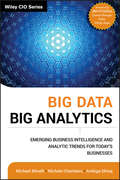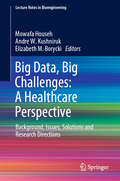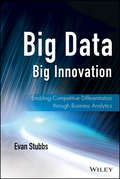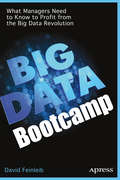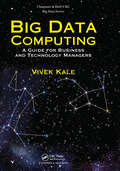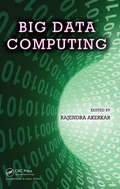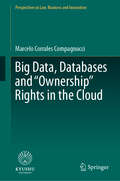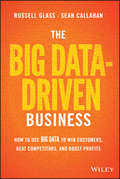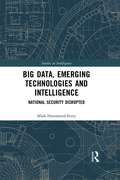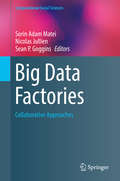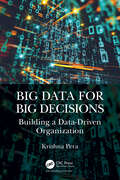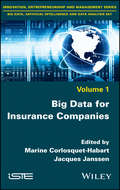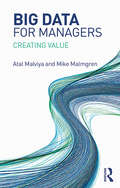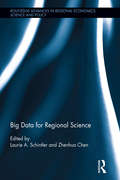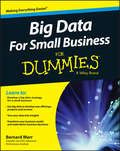- Table View
- List View
Big Data, Big Analytics: Emerging Business Intelligence and Analytic Trends for Today's Businesses (Wiley CIO #586)
by Michael Minelli Michele Chambers Ambiga DhirajUnique prospective on the big data analytics phenomenon for both business and IT professionals The availability of Big Data, low-cost commodity hardware and new information management and analytics software has produced a unique moment in the history of business. The convergence of these trends means that we have the capabilities required to analyze astonishing data sets quickly and cost-effectively for the first time in history. These capabilities are neither theoretical nor trivial. They represent a genuine leap forward and a clear opportunity to realize enormous gains in terms of efficiency, productivity, revenue and profitability. The Age of Big Data is here, and these are truly revolutionary times. This timely book looks at cutting-edge companies supporting an exciting new generation of business analytics. Learn more about the trends in big data and how they are impacting the business world (Risk, Marketing, Healthcare, Financial Services, etc.) Explains this new technology and how companies can use them effectively to gather the data that they need and glean critical insights Explores relevant topics such as data privacy, data visualization, unstructured data, crowd sourcing data scientists, cloud computing for big data, and much more.
Big Data, Big Analytics: Emerging Business Intelligence and Analytic Trends for Today's Businesses (Wiley CIO)
by Michael Minelli Michele Chambers Ambiga DhirajUnique prospective on the big data analytics phenomenon for both business and IT professionals The availability of Big Data, low-cost commodity hardware and new information management and analytics software has produced a unique moment in the history of business. The convergence of these trends means that we have the capabilities required to analyze astonishing data sets quickly and cost-effectively for the first time in history. These capabilities are neither theoretical nor trivial. They represent a genuine leap forward and a clear opportunity to realize enormous gains in terms of efficiency, productivity, revenue and profitability. The Age of Big Data is here, and these are truly revolutionary times. This timely book looks at cutting-edge companies supporting an exciting new generation of business analytics. Learn more about the trends in big data and how they are impacting the business world (Risk, Marketing, Healthcare, Financial Services, etc.) Explains this new technology and how companies can use them effectively to gather the data that they need and glean critical insights Explores relevant topics such as data privacy, data visualization, unstructured data, crowd sourcing data scientists, cloud computing for big data, and much more.
Big Data, Big Challenges: Background, Issues, Solutions and Research Directions (Lecture Notes in Bioengineering)
by Mowafa Househ Andre W. Kushniruk Elizabeth M. BoryckiThis is the first book to offer a comprehensive yet concise overview of the challenges and opportunities presented by the use of big data in healthcare. The respective chapters address a range of aspects: from health management to patient safety; from the human factor perspective to ethical and economic considerations, and many more. By providing a historical background on the use of big data, and critically analyzing current approaches together with issues and challenges related to their applications, the book not only sheds light on the problems entailed by big data, but also paves the way for possible solutions and future research directions. Accordingly, it offers an insightful reference guide for health information technology professionals, healthcare managers, healthcare practitioners, and patients alike, aiding them in their decision-making processes; and for students and researchers whose work involves data science-related research issues in healthcare.
Big Data, Big Innovation: Enabling Competitive Differentiation through Business Analytics (Wiley and SAS Business Series)
by Evan StubbsA practical guide to leveraging your data to spur innovation and growth Your business generates reams of data, but what do you do with it? Reporting is only the beginning. Your data holds the key to innovation and growth – you just need the proper analytics. In Big Data, Big Innovation: Enabling Competitive Differentiation Through Business Analytics, author Evan Stubbs explores the potential gold hiding in your un-mined data. As Chief Analytics Officer for SAS Australia/New Zealand, Stubbs brings an industry insider's perspective to guide you through pattern recognition, analysis, and implementation. Big Data, Big Innovation: Enabling Competitive Differentiation Through Business Analytics details a groundbreaking approach to ensuring your company's upward trajectory. Use this guide to leverage your customer information, financial reports, performance metrics, and more to build a rock-solid foundation for future growth. Build an effective analytics team, and empower them with the right tools Learn how big data drives both evolutionary and revolutionary innovation, and who should be responsible Identify data collection and analysis opportunities and implement action plans Design the platform that suits your company's current and future needs Quantify performance with statistics, programming, and research for a more complete picture of operations Effective management means combining data, people, and analytics to create a synergistic force for innovation and growth. If you want your company to move forward with confidence, Big Data, Big Innovation: Enabling Competitive Differentiation Through Business Analytics can show you how to use what you already have and acquire what you need to succeed.
Big Data, Big Innovation: Enabling Competitive Differentiation through Business Analytics (Wiley and SAS Business Series)
by Evan StubbsA practical guide to leveraging your data to spur innovation and growth Your business generates reams of data, but what do you do with it? Reporting is only the beginning. Your data holds the key to innovation and growth – you just need the proper analytics. In Big Data, Big Innovation: Enabling Competitive Differentiation Through Business Analytics, author Evan Stubbs explores the potential gold hiding in your un-mined data. As Chief Analytics Officer for SAS Australia/New Zealand, Stubbs brings an industry insider's perspective to guide you through pattern recognition, analysis, and implementation. Big Data, Big Innovation: Enabling Competitive Differentiation Through Business Analytics details a groundbreaking approach to ensuring your company's upward trajectory. Use this guide to leverage your customer information, financial reports, performance metrics, and more to build a rock-solid foundation for future growth. Build an effective analytics team, and empower them with the right tools Learn how big data drives both evolutionary and revolutionary innovation, and who should be responsible Identify data collection and analysis opportunities and implement action plans Design the platform that suits your company's current and future needs Quantify performance with statistics, programming, and research for a more complete picture of operations Effective management means combining data, people, and analytics to create a synergistic force for innovation and growth. If you want your company to move forward with confidence, Big Data, Big Innovation: Enabling Competitive Differentiation Through Business Analytics can show you how to use what you already have and acquire what you need to succeed.
Big Data Bootcamp: What Managers Need to Know to Profit from the Big Data Revolution
by David FeinleibInvestors and technology gurus have called big data one of the most important trends to come along in decades. Big Data Bootcamp explains what big data is and how you can use it in your company to become one of tomorrow’s market leaders. Along the way, it explains the very latest technologies, companies, and advancements.Big data holds the keys to delivering better customer service, offering more attractive products, and unlocking innovation. That’s why, to remain competitive, every organization should become a big data company. It’s also why every manager and technology professional should become knowledgeable about big data and how it is transforming not just their own industries but the global economy.And that knowledge is just what this book delivers. It explains components of big data like Hadoop and NoSQL databases; how big data is compiled, queried, and analyzed; how to create a big data application; and the business sectors ripe for big data-inspired products and services like retail, healthcare, finance, and education. Best of all, your guide is David Feinleib, renowned entrepreneur, venture capitalist, and author of Why Startups Fail. Feinleib’s Big Data Landscape, a market map featured and explained in the book, is an industry benchmark that has been viewed more than 150,000 times and is used as a reference by VMWare, Dell, Intel, the U.S. Government Accountability Office, and many other organizations. Feinleib also explains:• Why every businessperson needs to understand the fundamentals of big data or get run over by those who do• How big data differs from traditional database management systems• How to create and run a big data project• The technical details powering the big data revolutionWhether you’re a Fortune 500 executive or the proprietor of a restaurant or web design studio, Big Data Bootcamp will explain how you can take full advantage of new technologies to transform your company and your career.
Big Data Computing: A Guide for Business and Technology Managers (Chapman & Hall/CRC Big Data Series)
by Vivek KaleThis book unravels the mystery of Big Data computing and its power to transform business operations. The approach it uses will be helpful to any professional who must present a case for realizing Big Data computing solutions or to those who could be involved in a Big Data computing project. It provides a framework that enables business and technical managers to make optimal decisions necessary for the successful migration to Big Data computing environments and applications within their organizations.
Big Data Computing: A Guide for Business and Technology Managers (Chapman & Hall/CRC Big Data Series)
by Vivek KaleThis book unravels the mystery of Big Data computing and its power to transform business operations. The approach it uses will be helpful to any professional who must present a case for realizing Big Data computing solutions or to those who could be involved in a Big Data computing project. It provides a framework that enables business and technical managers to make optimal decisions necessary for the successful migration to Big Data computing environments and applications within their organizations.
Big Data Computing
Due to market forces and technological evolution, Big Data computing is developing at an increasing rate. A wide variety of novel approaches and tools have emerged to tackle the challenges of Big Data, creating both more opportunities and more challenges for students and professionals in the field of data computation and analysis. Presenting a mix
Big Data, Databases and "Ownership" Rights in the Cloud (Perspectives in Law, Business and Innovation)
by Marcelo Corrales CompagnucciTwo of the most important developments of this new century are the emergence of cloud computing and big data. However, the uncertainties surrounding the failure of cloud service providers to clearly assert ownership rights over data and databases during cloud computing transactions and big data services have been perceived as imposing legal risks and transaction costs. This lack of clear ownership rights is also seen as slowing down the capacity of the Internet market to thrive. Click-through agreements drafted on a take-it-or-leave-it basis govern the current state of the art, and they do not allow much room for negotiation. The novel contribution of this book proffers a new contractual model advocating the extension of the negotiation capabilities of cloud customers, thus enabling an automated and machine-readable framework, orchestrated by a cloud broker.Cloud computing and big data are constantly evolving and transforming into new paradigms where cloud brokers are predicted to play a vital role as innovation intermediaries adding extra value to the entire life cycle. This evolution will alleviate the legal uncertainties in society by means of embedding legal requirements in the user interface and related computer systems or its code. This book situates the theories of law and economics and behavioral law and economics in the context of cloud computing and takes database rights and ownership rights of data as prime examples to represent the problem of collecting, outsourcing, and sharing data and databases on a global scale. It does this by highlighting the legal constraints concerning ownership rights of data and databases and proposes finding a solution outside the boundaries and limitations of the law. By allowing cloud brokers to establish themselves in the market as entities coordinating and actively engaging in the negotiation of service-level agreements (SLAs), individual customers as well as small and medium-sized enterprises could efficiently and effortlessly choose a cloud provider that best suits their needs. This approach, which the author calls “plan-like architectures,” endeavors to create a more trustworthy cloud computing environment and to yield radical new results for the development of the cloud computing and big data markets.
The Big Data-Driven Business: How to Use Big Data to Win Customers, Beat Competitors, and Boost Profits
by Russell Glass Sean CallahanGet the expert perspective and practical advice on big data The Big Data-Driven Business: How to Use Big Data to Win Customers, Beat Competitors, and Boost Profits makes the case that big data is for real, and more than just big hype. The book uses real-life examples—from Nate Silver to Copernicus, and Apple to Blackberry—to demonstrate how the winners of the future will use big data to seek the truth. Written by a marketing journalist and the CEO of a multi-million-dollar B2B marketing platform that reaches more than 90% of the U.S. business population, this book is a comprehensive and accessible guide on how to win customers, beat competitors, and boost the bottom line with big data. The marketplace has entered an era where the customer holds all the cards. With unprecedented choice in both the consumer world and the B2B world, it's imperative that businesses gain a greater understanding of their customers and prospects. Big data is the key to this insight, because it provides a comprehensive view of a company's customers—who they are, and who they may be tomorrow. The Big Data-Driven Business is a complete guide to the future of business as seen through the lens of big data, with expert advice on real-world applications. Learn what big data is, and how it will transform the enterprise Explore why major corporations are betting their companies on marketing technology Read case studies of big data winners and losers Discover how to change privacy and security, and remodel marketing Better information allows for better decisions, better targeting, and better reach. Big data has become an indispensable tool for the most effective marketers in the business, and it's becoming less of a competitive advantage and more like an industry standard. Remaining relevant as the marketplace evolves requires a full understanding and application of big data, and The Big Data-Driven Business provides the practical guidance businesses need.
The Big Data-Driven Business: How to Use Big Data to Win Customers, Beat Competitors, and Boost Profits
by Russell Glass Sean CallahanGet the expert perspective and practical advice on big data The Big Data-Driven Business: How to Use Big Data to Win Customers, Beat Competitors, and Boost Profits makes the case that big data is for real, and more than just big hype. The book uses real-life examples—from Nate Silver to Copernicus, and Apple to Blackberry—to demonstrate how the winners of the future will use big data to seek the truth. Written by a marketing journalist and the CEO of a multi-million-dollar B2B marketing platform that reaches more than 90% of the U.S. business population, this book is a comprehensive and accessible guide on how to win customers, beat competitors, and boost the bottom line with big data. The marketplace has entered an era where the customer holds all the cards. With unprecedented choice in both the consumer world and the B2B world, it's imperative that businesses gain a greater understanding of their customers and prospects. Big data is the key to this insight, because it provides a comprehensive view of a company's customers—who they are, and who they may be tomorrow. The Big Data-Driven Business is a complete guide to the future of business as seen through the lens of big data, with expert advice on real-world applications. Learn what big data is, and how it will transform the enterprise Explore why major corporations are betting their companies on marketing technology Read case studies of big data winners and losers Discover how to change privacy and security, and remodel marketing Better information allows for better decisions, better targeting, and better reach. Big data has become an indispensable tool for the most effective marketers in the business, and it's becoming less of a competitive advantage and more like an industry standard. Remaining relevant as the marketplace evolves requires a full understanding and application of big data, and The Big Data-Driven Business provides the practical guidance businesses need.
Big Data, Emerging Technologies and Intelligence: National Security Disrupted (Studies in Intelligence)
by Miah Hammond-ErreyThis book sets out the big data landscape, comprising data abundance, digital connectivity and ubiquitous technology, and shows how the big data landscape and the emerging technologies it fuels are impacting national security.This book illustrates that big data is transforming intelligence production as well as changing the national security environment broadly, including what is considered a part of national security as well as the relationships agencies have with the public. The book highlights the impact of big data on intelligence production and national security from the perspective of Australian national security leaders and practitioners, and the research is based on empirical data collection, with insights from nearly 50 participants from within Australia’s National Intelligence Community. It argues that big data is transforming intelligence and national security and shows that the impacts of big data on the knowledge, activities and organisation of intelligence agencies is challenging some foundational intelligence principles, including the distinction between foreign and domestic intelligence collection. Furthermore, the book argues that big data has created emerging threats to national security; for example, it enables invasive targeting and surveillance, drives information warfare as well as social and political interference, and challenges the existing models of harm assessment used in national security. The book maps broad areas of change for intelligence agencies in the national security context and what they mean for intelligence communities, and explores how intelligence agencies look out to the rest of society, considering specific impacts relating to privacy, ethics and trust.This book will be of much interest to students of intelligence studies, technology studies, national security and International Relations.
Big Data, Emerging Technologies and Intelligence: National Security Disrupted (Studies in Intelligence)
by Miah Hammond-ErreyThis book sets out the big data landscape, comprising data abundance, digital connectivity and ubiquitous technology, and shows how the big data landscape and the emerging technologies it fuels are impacting national security.This book illustrates that big data is transforming intelligence production as well as changing the national security environment broadly, including what is considered a part of national security as well as the relationships agencies have with the public. The book highlights the impact of big data on intelligence production and national security from the perspective of Australian national security leaders and practitioners, and the research is based on empirical data collection, with insights from nearly 50 participants from within Australia’s National Intelligence Community. It argues that big data is transforming intelligence and national security and shows that the impacts of big data on the knowledge, activities and organisation of intelligence agencies is challenging some foundational intelligence principles, including the distinction between foreign and domestic intelligence collection. Furthermore, the book argues that big data has created emerging threats to national security; for example, it enables invasive targeting and surveillance, drives information warfare as well as social and political interference, and challenges the existing models of harm assessment used in national security. The book maps broad areas of change for intelligence agencies in the national security context and what they mean for intelligence communities, and explores how intelligence agencies look out to the rest of society, considering specific impacts relating to privacy, ethics and trust.This book will be of much interest to students of intelligence studies, technology studies, national security and International Relations.
Big Data Factories: Collaborative Approaches (Computational Social Sciences)
by Sorin Adam Matei Nicolas Jullien Sean P. GogginsThe book proposes a systematic approach to big data collection, documentation and development of analytic procedures that foster collaboration on a large scale. This approach, designated as “data factoring” emphasizes the need to think of each individual dataset developed by an individual project as part of a broader data ecosystem, easily accessible and exploitable by parties not directly involved with data collection and documentation. Furthermore, data factoring uses and encourages pre-analytic operations that add value to big data sets, especially recombining and repurposing.The book proposes a research-development agenda that can undergird an ideal data factory approach. Several programmatic chapters discuss specialized issues involved in data factoring (documentation, meta-data specification, building flexible, yet comprehensive data ontologies, usability issues involved in collaborative tools, etc.). The book also presents case studies for data factoring and processing that can lead to building better scientific collaboration and data sharing strategies and tools.Finally, the book presents the teaching utility of data factoring and the ethical and privacy concerns related to it.Chapter 9 of this book is available open access under a CC BY 4.0 license at link.springer.com
Big Data for Big Decisions: Building a Data-Driven Organization
by Krishna PeraBuilding a data-driven organization (DDO) is an enterprise-wide initiative that may consume and lock up resources for the long term. Understandably, any organization considering such an initiative would insist on a roadmap and business case to be prepared and evaluated prior to approval. This book presents a step-by-step methodology in order to create a roadmap and business case, and provides a narration of the constraints and experiences of managers who have attempted the setting up of DDOs. The emphasis is on the big decisions – the key decisions that influence 90% of business outcomes – starting from decision first and reengineering the data to the decisions process-chain and data governance, so as to ensure the right data are available at the right time, every time. Investing in artificial intelligence and data-driven decision making are now being considered a survival necessity for organizations to stay competitive. While every enterprise aspires to become 100% data-driven and every Chief Information Officer (CIO) has a budget, Gartner estimates over 80% of all analytics projects fail to deliver intended value. Most CIOs think a data-driven organization is a distant dream, especially while they are still struggling to explain the value from analytics. They know a few isolated successes, or a one-time leveraging of big data for decision making does not make an organization data-driven. As of now, there is no precise definition for data-driven organization or what qualifies an organization to call itself data-driven. Given the hype in the market for big data, analytics and AI, every CIO has a budget for analytics, but very little clarity on where to begin or how to choose and prioritize the analytics projects. Most end up investing in a visualization platform like Tableau or QlikView, which in essence is an improved version of their BI dashboard that the organization had invested into not too long ago. The most important stakeholders, the decision-makers, are rarely kept in the loop while choosing analytics projects. This book provides a fail-safe methodology for assured success in deriving intended value from investments into analytics. It is a practitioners’ handbook for creating a step-by-step transformational roadmap prioritizing the big data for the big decisions, the 10% of decisions that influence 90% of business outcomes, and delivering material improvements in the quality of decisions, as well as measurable value from analytics investments. The acid test for a data-driven organization is when all the big decisions, especially top-level strategic decisions, are taken based on data and not on the collective gut feeling of the decision makers in the organization.
Big Data for Big Decisions: Building a Data-Driven Organization
by Krishna PeraBuilding a data-driven organization (DDO) is an enterprise-wide initiative that may consume and lock up resources for the long term. Understandably, any organization considering such an initiative would insist on a roadmap and business case to be prepared and evaluated prior to approval. This book presents a step-by-step methodology in order to create a roadmap and business case, and provides a narration of the constraints and experiences of managers who have attempted the setting up of DDOs. The emphasis is on the big decisions – the key decisions that influence 90% of business outcomes – starting from decision first and reengineering the data to the decisions process-chain and data governance, so as to ensure the right data are available at the right time, every time. Investing in artificial intelligence and data-driven decision making are now being considered a survival necessity for organizations to stay competitive. While every enterprise aspires to become 100% data-driven and every Chief Information Officer (CIO) has a budget, Gartner estimates over 80% of all analytics projects fail to deliver intended value. Most CIOs think a data-driven organization is a distant dream, especially while they are still struggling to explain the value from analytics. They know a few isolated successes, or a one-time leveraging of big data for decision making does not make an organization data-driven. As of now, there is no precise definition for data-driven organization or what qualifies an organization to call itself data-driven. Given the hype in the market for big data, analytics and AI, every CIO has a budget for analytics, but very little clarity on where to begin or how to choose and prioritize the analytics projects. Most end up investing in a visualization platform like Tableau or QlikView, which in essence is an improved version of their BI dashboard that the organization had invested into not too long ago. The most important stakeholders, the decision-makers, are rarely kept in the loop while choosing analytics projects. This book provides a fail-safe methodology for assured success in deriving intended value from investments into analytics. It is a practitioners’ handbook for creating a step-by-step transformational roadmap prioritizing the big data for the big decisions, the 10% of decisions that influence 90% of business outcomes, and delivering material improvements in the quality of decisions, as well as measurable value from analytics investments. The acid test for a data-driven organization is when all the big decisions, especially top-level strategic decisions, are taken based on data and not on the collective gut feeling of the decision makers in the organization.
Big Data for Insurance Companies
by Marine Corlosquet-Habart Jacques JanssenThis book will be a "must" for people who want good knowledge of big data concepts and their applications in the real world, particularly in the field of insurance. It will be useful to people working in finance and to masters students using big data tools. The authors present the bases of big data: data analysis methods, learning processes, application to insurance and position within the insurance market. Individual chapters a will be written by well-known authors in this field.
Big Data for Insurance Companies
by Marine Corlosquet-Habart Jacques JanssenThis book will be a "must" for people who want good knowledge of big data concepts and their applications in the real world, particularly in the field of insurance. It will be useful to people working in finance and to masters students using big data tools. The authors present the bases of big data: data analysis methods, learning processes, application to insurance and position within the insurance market. Individual chapters a will be written by well-known authors in this field.
Big Data for Managers: Creating Value
by Atal Malviya Mike MalmgrenIn today’s fast growing digital world, the web, mobile, social networks and other digital platforms are producing enormous amounts of data that hold intelligence and valuable information. Correctly used it has the power to create sustainable value in different forms for businesses. The commonly used term for this data is Big Data, which includes structured, unstructured and hybrid structured data. However, Big Data is of limited value unless insightful information can be extracted from the sources of data. The solution is Big Data analytics, and how managers and executives can capture value from this vast resource of information and insights. This book develops a simple framework and a non-technical approach to help the reader understand, digest and analyze data, and produce meaningful analytics to make informed decisions. It will support value creation within businesses, from customer care to product innovation, from sales and marketing to operational performance. The authors provide multiple case studies on global industries and business units, chapter summaries and discussion questions for the reader to consider and explore. Big Data for Managers also presents small cases and challenges for the reader to work on – making this a thorough and practical guide for students and managers.
Big Data for Managers: Creating Value
by Atal Malviya Mike MalmgrenIn today’s fast growing digital world, the web, mobile, social networks and other digital platforms are producing enormous amounts of data that hold intelligence and valuable information. Correctly used it has the power to create sustainable value in different forms for businesses. The commonly used term for this data is Big Data, which includes structured, unstructured and hybrid structured data. However, Big Data is of limited value unless insightful information can be extracted from the sources of data. The solution is Big Data analytics, and how managers and executives can capture value from this vast resource of information and insights. This book develops a simple framework and a non-technical approach to help the reader understand, digest and analyze data, and produce meaningful analytics to make informed decisions. It will support value creation within businesses, from customer care to product innovation, from sales and marketing to operational performance. The authors provide multiple case studies on global industries and business units, chapter summaries and discussion questions for the reader to consider and explore. Big Data for Managers also presents small cases and challenges for the reader to work on – making this a thorough and practical guide for students and managers.
Big Data for Regional Science (Routledge Advances in Regional Economics, Science and Policy)
Recent technological advancements and other related factors and trends are contributing to the production of an astoundingly large and rapidly accelerating collection of data, or ‘Big Data’. This data now allows us to examine urban and regional phenomena in ways that were previously not possible. Despite the tremendous potential of big data for regional science, its use and application in this context is fraught with issues and challenges. This book brings together leading contributors to present an interdisciplinary, agenda-setting and action-oriented platform for research and practice in the urban and regional community. This book provides a comprehensive, multidisciplinary and cutting-edge perspective on big data for regional science. Chapters contain a collection of research notes contributed by experts from all over the world with a wide array of disciplinary backgrounds. The content is organized along four themes: sources of big data; integration, processing and management of big data; analytics for big data; and, higher level policy and programmatic considerations. As well as concisely and comprehensively synthesising work done to date, the book also considers future challenges and prospects for the use of big data in regional science. Big Data for Regional Science provides a seminal contribution to the field of regional science and will appeal to a broad audience, including those at all levels of academia, industry, and government.
Big Data for Regional Science (Routledge Advances in Regional Economics, Science and Policy)
Recent technological advancements and other related factors and trends are contributing to the production of an astoundingly large and rapidly accelerating collection of data, or ‘Big Data’. This data now allows us to examine urban and regional phenomena in ways that were previously not possible. Despite the tremendous potential of big data for regional science, its use and application in this context is fraught with issues and challenges. This book brings together leading contributors to present an interdisciplinary, agenda-setting and action-oriented platform for research and practice in the urban and regional community. This book provides a comprehensive, multidisciplinary and cutting-edge perspective on big data for regional science. Chapters contain a collection of research notes contributed by experts from all over the world with a wide array of disciplinary backgrounds. The content is organized along four themes: sources of big data; integration, processing and management of big data; analytics for big data; and, higher level policy and programmatic considerations. As well as concisely and comprehensively synthesising work done to date, the book also considers future challenges and prospects for the use of big data in regional science. Big Data for Regional Science provides a seminal contribution to the field of regional science and will appeal to a broad audience, including those at all levels of academia, industry, and government.
Big Data For Small Business For Dummies
by Bernard MarrCapitalise on big data to add value to your small business Written by bestselling author and big data expert Bernard Marr, Big Data For Small Business For Dummies helps you understand what big data actually is—and how you can analyse and use it to improve your business. Free of confusing jargon and complemented with lots of step-by-step guidance and helpful advice, it quickly and painlessly helps you get the most from using big data in a small business. Business data has been around for a long time. Unfortunately, it was trapped away in overcrowded filing cabinets and on archaic floppy disks. Now, thanks to technology and new tools that display complex databases in a much simpler manner, small businesses can benefit from the big data that's been hiding right under their noses. With the help of this friendly guide, you'll discover how to get your hands on big data to develop new offerings, products and services; understand technological change; create an infrastructure; develop strategies; and make smarter business decisions. Shows you how to use big data to make sense of user activity on social networks and customer transactions Demonstrates how to capture, store, search, share, analyse and visualise analytics Helps you turn your data into actionable insights Explains how to use big data to your advantage in order to transform your small business If you're a small business owner or employee, Big Data For Small Business For Dummies helps you harness the hottest commodity on the market today in order to take your company to new heights.
Big Data For Small Business For Dummies
by Bernard MarrCapitalise on big data to add value to your small business Written by bestselling author and big data expert Bernard Marr, Big Data For Small Business For Dummies helps you understand what big data actually is—and how you can analyse and use it to improve your business. Free of confusing jargon and complemented with lots of step-by-step guidance and helpful advice, it quickly and painlessly helps you get the most from using big data in a small business. Business data has been around for a long time. Unfortunately, it was trapped away in overcrowded filing cabinets and on archaic floppy disks. Now, thanks to technology and new tools that display complex databases in a much simpler manner, small businesses can benefit from the big data that's been hiding right under their noses. With the help of this friendly guide, you'll discover how to get your hands on big data to develop new offerings, products and services; understand technological change; create an infrastructure; develop strategies; and make smarter business decisions. Shows you how to use big data to make sense of user activity on social networks and customer transactions Demonstrates how to capture, store, search, share, analyse and visualise analytics Helps you turn your data into actionable insights Explains how to use big data to your advantage in order to transform your small business If you're a small business owner or employee, Big Data For Small Business For Dummies helps you harness the hottest commodity on the market today in order to take your company to new heights.
